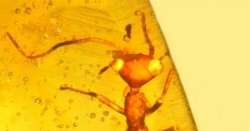Scientists discover 100-million-year-old 'ET-like' insect species
A 100-million-year-old insect species with a triangular head has been discovered by a team of scientists at the Oregon State University. The features of the insect are so unusual that it has been placed in

A 100-million-year-old insect species with a triangular head has been discovered by a team of scientists at the Oregon State University.
The features of the insect are so unusual that it has been placed in a new scientific order - an incredibly rare event. There are about one million described species of insects, and millions more still to be discovered, but every species of insect on Earth has been placed in only 31 existing orders.
The small, wingless female insect that probably lived in fissures in the bark of trees, looking for mites, worms or fungi to feed on while dinosaurs lumbered nearby. It was tiny, but scary looking.
"This insect has a number of features that just don't match those of any other insect species that I know," said George Poinar, a professor at Oregon State University in the US.
"I had never really seen anything like it. It appears to be unique in the insect world, and after considerable discussion we decided it had to take its place in a new order," Poinar said.
Perhaps most unusual was a triangular head with bulging eyes, with the vertex of the right triangle located at the base of the neck, said Poinar.
This is different from any other known insect, and would have given this species the ability to see almost 180 degrees by turning its head sideways.
The insect, probably an omnivore, also had a long, narrow, flat body, and long slender legs. It could have moved quickly, and literally seen behind itself.
It also had glands on the neck that secreted a deposit that scientists believe most likely was a chemical to repel predators.
The insect has been assigned to the newly created order Aethiocarenodea, and the species has been named Aethiocarenus burmanicus, in reference to the Hukawng Valley mines of Myanmar where it was found.
Only one other specimen of this insect has been located, also preserved in Burmese amber, Poinar said.
Those two specimens, which clearly belong to the same species, now comprise the totality of the order Aethiocarenodea.
Needless to say, this species from such ancient amber is long extinct. It obviously had special features that allowed it to survive in the forests of what is now Burma, 100 million years ago, but for some unknown reason it disappeared.
Loss of its preferred habitat is a likely possibility. "The strangest thing about this insect is that the head looked so much like the way aliens are often portrayed," Poinar said. The findings have been published in the journal Cretaceous Research.
(With inputs from PTI)